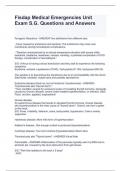Fisdap Medical Emergencies Unit
Exam S.G. Questions and Answers
Pyrogenic Reactions - ANSWER-Two definitions from different sets:
- Fever caused by endotoxins and bacteria. The endotoxins may cross over
membranes during hemodialysis complications.
- "Reaction characterized by an abrupt temperature elevation with severe chills,
backache, headache, weakness, nausea, vomiting; a potential complication of IV/IO
therapy, complication of hemodialysis."
S/G: If the pt is having a blood transfusion and they start to experience the following
symptoms:
Erythema, urticaria, hypotension (70/40), Tachycardia (P 120), tachypnea (RR 24).
The solution is to discontinue the transfusion due to an incompatibility with the donor.
Start fluids, benadryl, maybe lasix and possibly epinephrine.
Endocrine disease (Such as, but not limited to, thyrotoxicosis) - ANSWER-
Thyrotoxicosis aka "thyroid storm" :
"Toxic condition caused by excessive levels of circulating thyroid hormone. Generally
caused by Grave's disease, severe under-treated hyperthyroidism, or infection. S&S:
Flush, red skin, agitated, angioedema"
Graves disease:
An autoimmune disease that results in elevated thyroid hormone. Graves disease
aka Hyperthyroidism is the main cause of "thyroid storm". Grave's can form a goiter
on the neck.
S/S: Fever, irritability, delerium, coma, tachycardia, hypotension. Care is mainly
supportive.
Hashimoto disease: More mild form of hyperthyroidism
Addison's disease : Not enough cortisol is produced (hypoadrenalism)
Cushing's disease: Too much cortisol (Hyperadrenalism) Moon face
Thyrotoxicosis aka "Thyroid storm" - ANSWER-Visual Aide
Pancreatitis - ANSWER-Inflammation of the pancreas typically seen by EMS due to
alcoholic pts. Caused by bile duct obstruction from gall stones
S/S: "Pain that radiates to the back x 5 days"
- NVD
,- RUQ pain
- Mid-abdominal tenderness
- CULLENS SIGN due to intrabdominal bleeding
Airway infections: laryngotracheobronchitis aka "Croup" - ANSWER-
laryngotracheobronchitis aka "Croup"
Viral Infection of Upper Airway Inflammation of the larynx, trachea, bronchi
strongest S&S at night--> severe respiratory distress
Stridor, Hoarseness, Barking Cough, dyspnea/respiratory distress, low grade fever,
hypoxia, nose inhalations
Airway Mangement
BVM, High Flow o2
Tube size might be 2 times smaller than normal size
Racemic Epinephrine 0.5 mL mixed with 3ms of normal saline
Airway infections (Others) - ANSWER-- Epiglottitis: Fever, Drooling
- Respiratory syncytial virus
- Bronchiolitis
- Pneumonia (Single sided fluid in the lungs)
- Pertussis (Whooping cough)
- Influenza type A
Tuberculosis - ANSWER-An infectious disease that may affect almost all tissues of
the body, especially the lungs
"26 yom c/o chest pain and hemoptysis. Pt has a productive cough with purulent,
bloody discharge and a low grade fever. What is it?"
TB can manifest in many ways. S/S include; Night sweats, hemoptysis, chills, fever,
fatigue, and weight loss. Don a N95 mask and mask up the pt.
Bleeding Disorders - ANSWER-- Sickle Cell disease: RBC's are "sickle shaped" and
interfere with oxygenation. This causes hypoxia throughout the body and causes
excessive pain. Provide supportive measures and GIVE PAIN MEDS (Morphine
Sulfate IV).
"24 yom w/ hx of sickle cell Lying in the fetal position"
- Disseminated Intravascular Coagulation:
Found in severe trauma and septic patients. Causes weird clotting AND bleeding
throughout the body.
Common sign is purpura on the chest and abdomen
-Hemophilia: Hereditary disorder with very poor clotting
, - Thrombocytopenia: Poor clotting due to a low level of platelets
- Thrombocytosis: Too many platelets (Asymptomatic)
Coagulation Processes - ANSWER-Steps:
1. Vasoconstriction
2. Platelet Plugging
3. Coagulation
Clotting cascade:
Refers to the process by which clotting factors work together to ultimately form fibrin
Coagulopathy:
A condition in which the blood's ability to coagulate (form clots) is impaired
Physiology Electrical Injuries - ANSWER-Produce devastating internal injuries with
little external evidence
may have two injuries sites
1. one at the point where electricity entered the body (entry wound)
2.and where it exited the body (exit wound)
as electrical current travels from the contact site into the body, it is converted to heat,
which follows the current flow--usually along side blood vessels and nerves--causing
extensive damage to the tissue in its path.
respiratory muscle paralysis
ventricular fibrillation
serious injury because the electricity may have flowed across the chest, potentially
injuring the cardiac conduction system
"11,000 volts usually fatal, 40,000 volts almost always fatal."
Pathophysiology of Angioedema - ANSWER-"A vascular reaction, that may have am
allergic cause and may result in profound swelling of tongue and lips"
"Marked edema of the skin and usually involves the head, neck, face, and upper
airway. Caused from allergic reactions and anaphylaxis."
- Sudden onset of dyspnea & swollen tongue = Immediate Epinephrine, benadryl,
breathing treatment. The vasoconstriction relieves the angioedema
- Watery eyes and "eyelid edema" with a food allergy and semi normal VS =
Diphenhydramine. S/S are local NOT systemic
Allergic reaction/anaphylaxis - ANSWER-Visual aide
Signs & Symptoms




